Comparison of Nervous and Endocrine Systems
VerifiedAdded on 2020/10/23
|8
|1927
|477
AI Summary
The assignment discusses the biological communication systems in humans, including glands, nerves, and hormones that use chemical messengers to communicate within the body. It focuses on the structure of the central nervous system, comprising the brain and spinal cord connected by medulla oblongata, and controls body actions. The comparison between nerve and hormone modes of action is also presented, emphasizing their distinct characteristics in transmission speed, reversibility, and permanence.
Contribute Materials
Your contribution can guide someone’s learning journey. Share your
documents today.
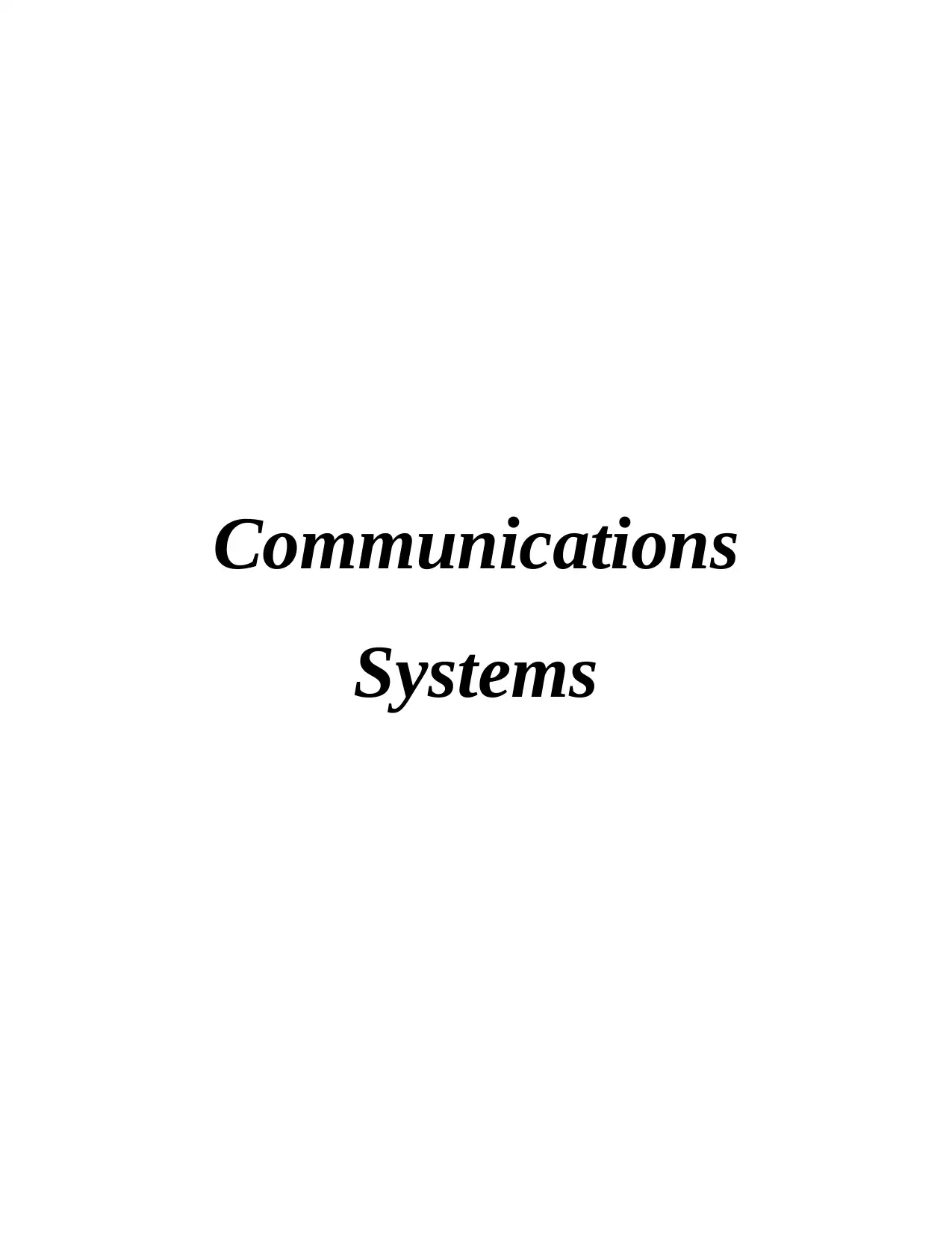
Communications
Systems
Systems
Secure Best Marks with AI Grader
Need help grading? Try our AI Grader for instant feedback on your assignments.
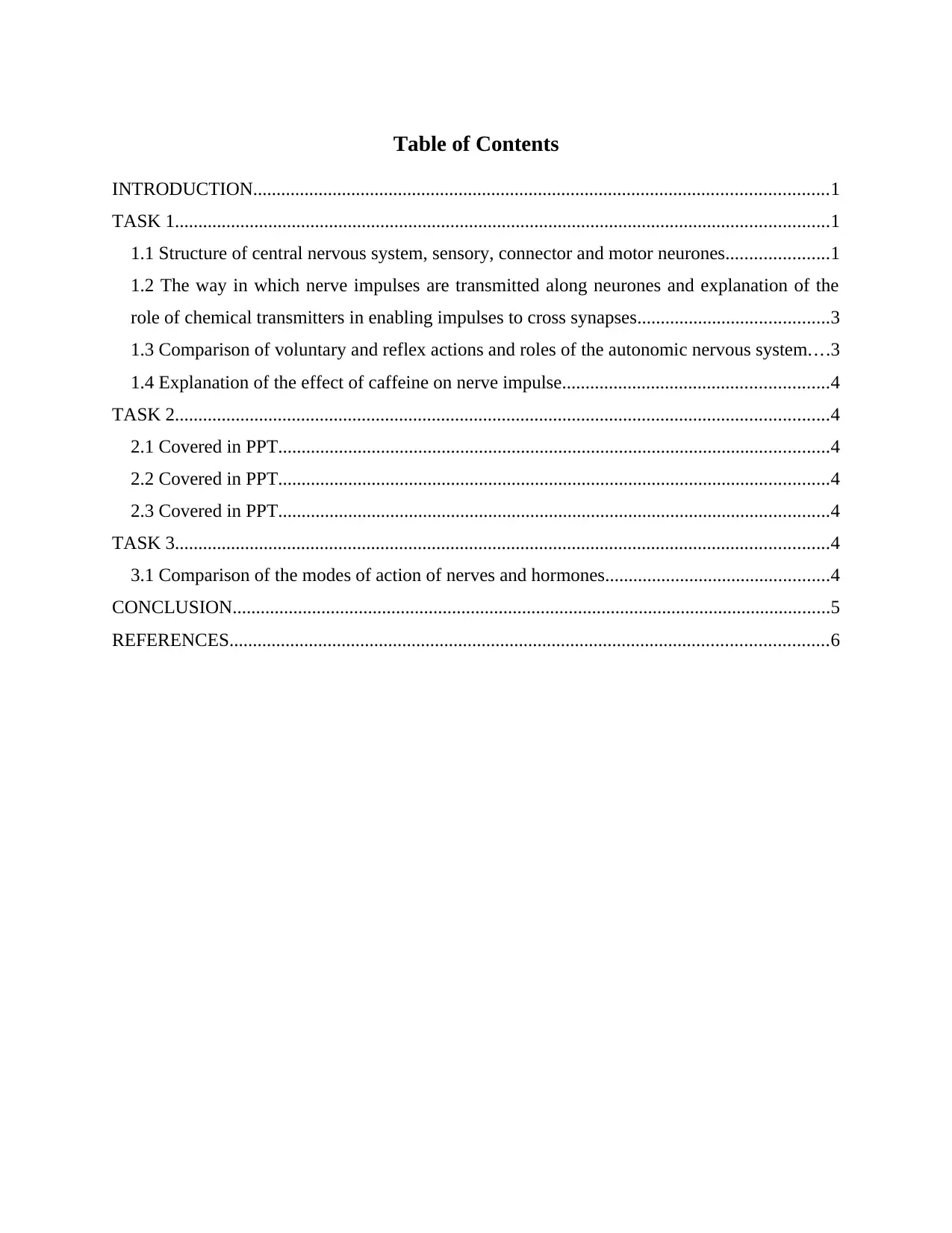
Table of Contents
INTRODUCTION...........................................................................................................................1
TASK 1............................................................................................................................................1
1.1 Structure of central nervous system, sensory, connector and motor neurones......................1
1.2 The way in which nerve impulses are transmitted along neurones and explanation of the
role of chemical transmitters in enabling impulses to cross synapses.........................................3
1.3 Comparison of voluntary and reflex actions and roles of the autonomic nervous system....3
1.4 Explanation of the effect of caffeine on nerve impulse.........................................................4
TASK 2............................................................................................................................................4
2.1 Covered in PPT......................................................................................................................4
2.2 Covered in PPT......................................................................................................................4
2.3 Covered in PPT......................................................................................................................4
TASK 3............................................................................................................................................4
3.1 Comparison of the modes of action of nerves and hormones................................................4
CONCLUSION................................................................................................................................5
REFERENCES................................................................................................................................6
INTRODUCTION...........................................................................................................................1
TASK 1............................................................................................................................................1
1.1 Structure of central nervous system, sensory, connector and motor neurones......................1
1.2 The way in which nerve impulses are transmitted along neurones and explanation of the
role of chemical transmitters in enabling impulses to cross synapses.........................................3
1.3 Comparison of voluntary and reflex actions and roles of the autonomic nervous system....3
1.4 Explanation of the effect of caffeine on nerve impulse.........................................................4
TASK 2............................................................................................................................................4
2.1 Covered in PPT......................................................................................................................4
2.2 Covered in PPT......................................................................................................................4
2.3 Covered in PPT......................................................................................................................4
TASK 3............................................................................................................................................4
3.1 Comparison of the modes of action of nerves and hormones................................................4
CONCLUSION................................................................................................................................5
REFERENCES................................................................................................................................6
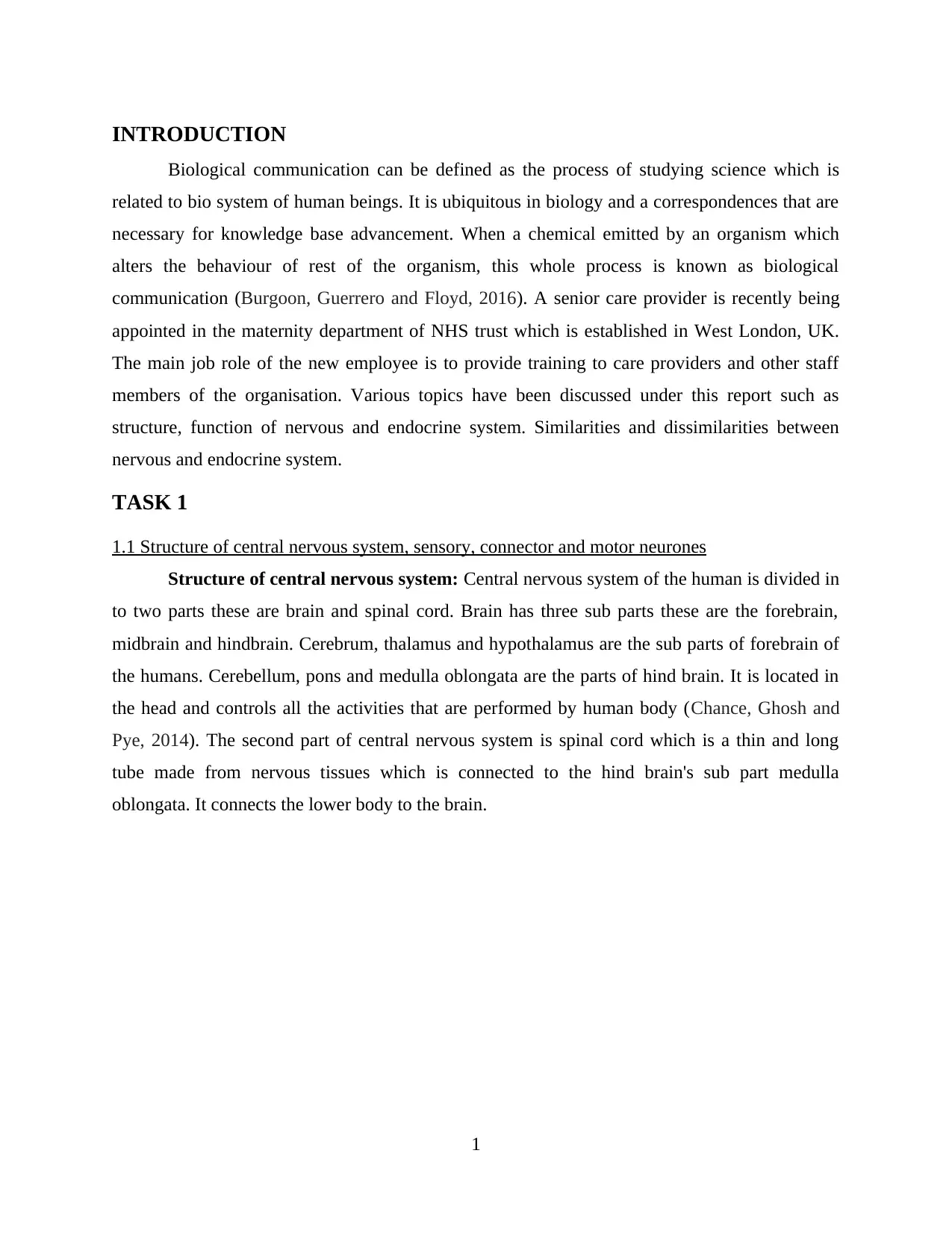
INTRODUCTION
Biological communication can be defined as the process of studying science which is
related to bio system of human beings. It is ubiquitous in biology and a correspondences that are
necessary for knowledge base advancement. When a chemical emitted by an organism which
alters the behaviour of rest of the organism, this whole process is known as biological
communication (Burgoon, Guerrero and Floyd, 2016). A senior care provider is recently being
appointed in the maternity department of NHS trust which is established in West London, UK.
The main job role of the new employee is to provide training to care providers and other staff
members of the organisation. Various topics have been discussed under this report such as
structure, function of nervous and endocrine system. Similarities and dissimilarities between
nervous and endocrine system.
TASK 1
1.1 Structure of central nervous system, sensory, connector and motor neurones
Structure of central nervous system: Central nervous system of the human is divided in
to two parts these are brain and spinal cord. Brain has three sub parts these are the forebrain,
midbrain and hindbrain. Cerebrum, thalamus and hypothalamus are the sub parts of forebrain of
the humans. Cerebellum, pons and medulla oblongata are the parts of hind brain. It is located in
the head and controls all the activities that are performed by human body (Chance, Ghosh and
Pye, 2014). The second part of central nervous system is spinal cord which is a thin and long
tube made from nervous tissues which is connected to the hind brain's sub part medulla
oblongata. It connects the lower body to the brain.
1
Biological communication can be defined as the process of studying science which is
related to bio system of human beings. It is ubiquitous in biology and a correspondences that are
necessary for knowledge base advancement. When a chemical emitted by an organism which
alters the behaviour of rest of the organism, this whole process is known as biological
communication (Burgoon, Guerrero and Floyd, 2016). A senior care provider is recently being
appointed in the maternity department of NHS trust which is established in West London, UK.
The main job role of the new employee is to provide training to care providers and other staff
members of the organisation. Various topics have been discussed under this report such as
structure, function of nervous and endocrine system. Similarities and dissimilarities between
nervous and endocrine system.
TASK 1
1.1 Structure of central nervous system, sensory, connector and motor neurones
Structure of central nervous system: Central nervous system of the human is divided in
to two parts these are brain and spinal cord. Brain has three sub parts these are the forebrain,
midbrain and hindbrain. Cerebrum, thalamus and hypothalamus are the sub parts of forebrain of
the humans. Cerebellum, pons and medulla oblongata are the parts of hind brain. It is located in
the head and controls all the activities that are performed by human body (Chance, Ghosh and
Pye, 2014). The second part of central nervous system is spinal cord which is a thin and long
tube made from nervous tissues which is connected to the hind brain's sub part medulla
oblongata. It connects the lower body to the brain.
1
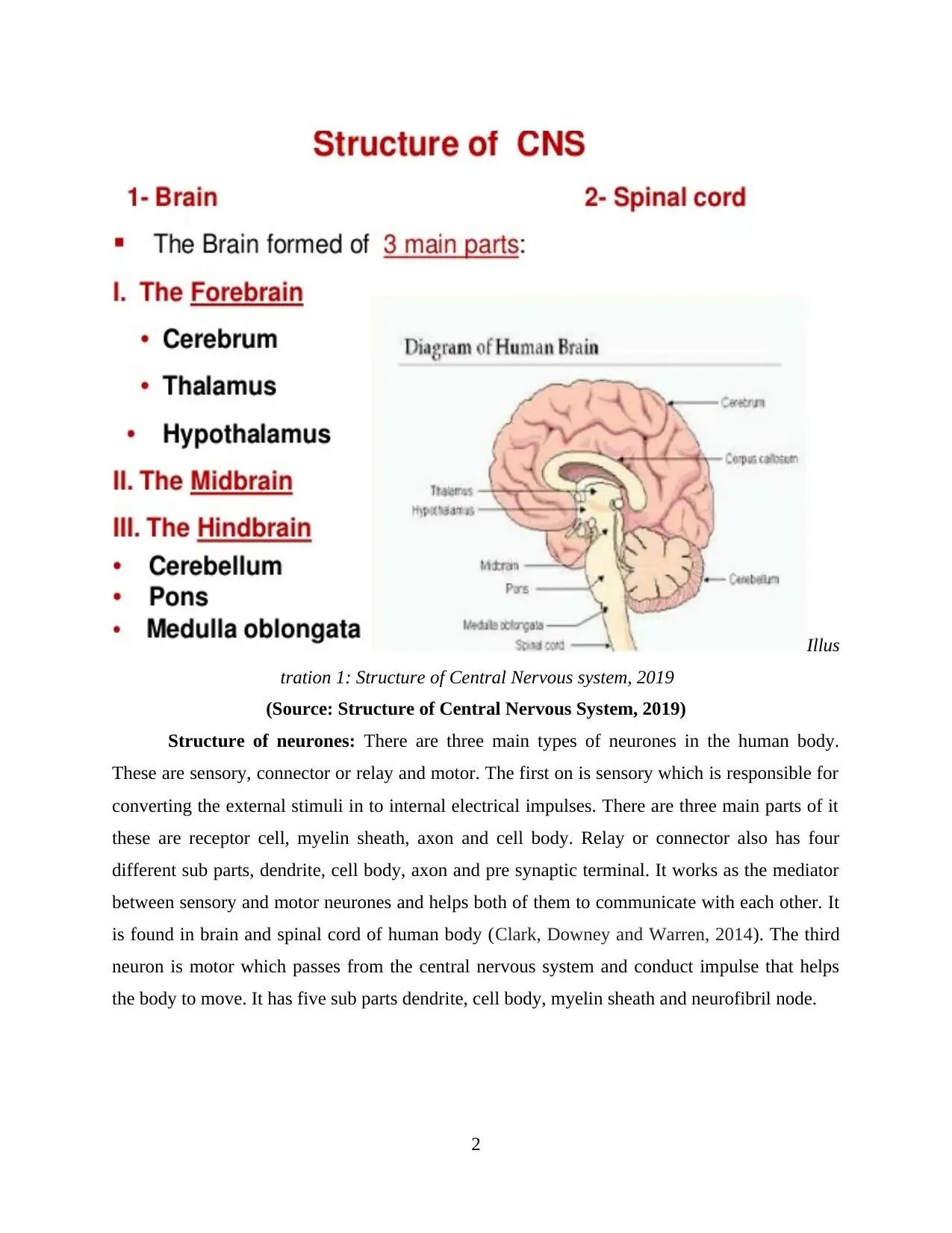
(Source: Structure of Central Nervous System, 2019)
Structure of neurones: There are three main types of neurones in the human body.
These are sensory, connector or relay and motor. The first on is sensory which is responsible for
converting the external stimuli in to internal electrical impulses. There are three main parts of it
these are receptor cell, myelin sheath, axon and cell body. Relay or connector also has four
different sub parts, dendrite, cell body, axon and pre synaptic terminal. It works as the mediator
between sensory and motor neurones and helps both of them to communicate with each other. It
is found in brain and spinal cord of human body (Clark, Downey and Warren, 2014). The third
neuron is motor which passes from the central nervous system and conduct impulse that helps
the body to move. It has five sub parts dendrite, cell body, myelin sheath and neurofibril node.
2
Illus
tration 1: Structure of Central Nervous system, 2019
Structure of neurones: There are three main types of neurones in the human body.
These are sensory, connector or relay and motor. The first on is sensory which is responsible for
converting the external stimuli in to internal electrical impulses. There are three main parts of it
these are receptor cell, myelin sheath, axon and cell body. Relay or connector also has four
different sub parts, dendrite, cell body, axon and pre synaptic terminal. It works as the mediator
between sensory and motor neurones and helps both of them to communicate with each other. It
is found in brain and spinal cord of human body (Clark, Downey and Warren, 2014). The third
neuron is motor which passes from the central nervous system and conduct impulse that helps
the body to move. It has five sub parts dendrite, cell body, myelin sheath and neurofibril node.
2
Illus
tration 1: Structure of Central Nervous system, 2019
Secure Best Marks with AI Grader
Need help grading? Try our AI Grader for instant feedback on your assignments.
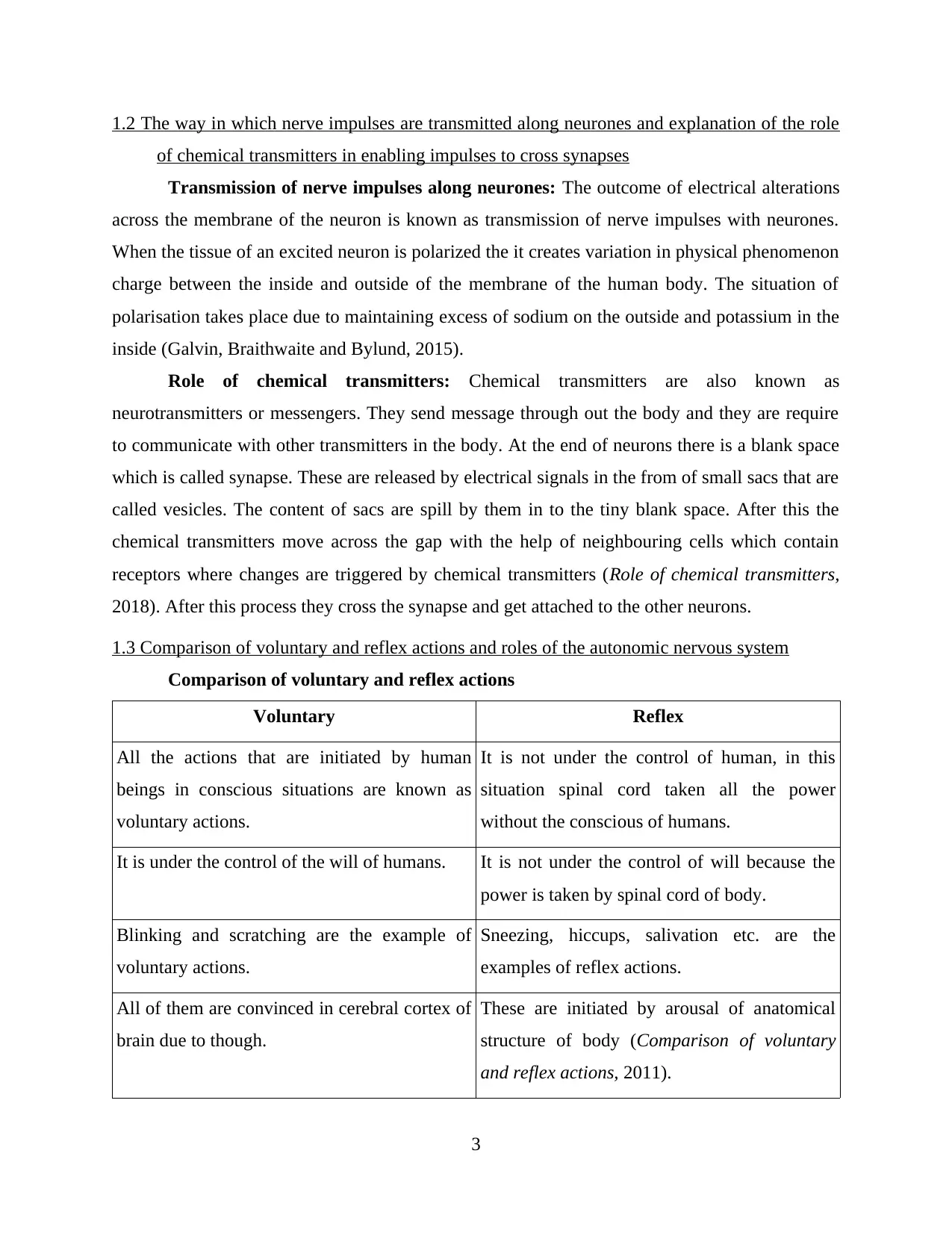
1.2 The way in which nerve impulses are transmitted along neurones and explanation of the role
of chemical transmitters in enabling impulses to cross synapses
Transmission of nerve impulses along neurones: The outcome of electrical alterations
across the membrane of the neuron is known as transmission of nerve impulses with neurones.
When the tissue of an excited neuron is polarized the it creates variation in physical phenomenon
charge between the inside and outside of the membrane of the human body. The situation of
polarisation takes place due to maintaining excess of sodium on the outside and potassium in the
inside (Galvin, Braithwaite and Bylund, 2015).
Role of chemical transmitters: Chemical transmitters are also known as
neurotransmitters or messengers. They send message through out the body and they are require
to communicate with other transmitters in the body. At the end of neurons there is a blank space
which is called synapse. These are released by electrical signals in the from of small sacs that are
called vesicles. The content of sacs are spill by them in to the tiny blank space. After this the
chemical transmitters move across the gap with the help of neighbouring cells which contain
receptors where changes are triggered by chemical transmitters (Role of chemical transmitters,
2018). After this process they cross the synapse and get attached to the other neurons.
1.3 Comparison of voluntary and reflex actions and roles of the autonomic nervous system
Comparison of voluntary and reflex actions
Voluntary Reflex
All the actions that are initiated by human
beings in conscious situations are known as
voluntary actions.
It is not under the control of human, in this
situation spinal cord taken all the power
without the conscious of humans.
It is under the control of the will of humans. It is not under the control of will because the
power is taken by spinal cord of body.
Blinking and scratching are the example of
voluntary actions.
Sneezing, hiccups, salivation etc. are the
examples of reflex actions.
All of them are convinced in cerebral cortex of
brain due to though.
These are initiated by arousal of anatomical
structure of body (Comparison of voluntary
and reflex actions, 2011).
3
of chemical transmitters in enabling impulses to cross synapses
Transmission of nerve impulses along neurones: The outcome of electrical alterations
across the membrane of the neuron is known as transmission of nerve impulses with neurones.
When the tissue of an excited neuron is polarized the it creates variation in physical phenomenon
charge between the inside and outside of the membrane of the human body. The situation of
polarisation takes place due to maintaining excess of sodium on the outside and potassium in the
inside (Galvin, Braithwaite and Bylund, 2015).
Role of chemical transmitters: Chemical transmitters are also known as
neurotransmitters or messengers. They send message through out the body and they are require
to communicate with other transmitters in the body. At the end of neurons there is a blank space
which is called synapse. These are released by electrical signals in the from of small sacs that are
called vesicles. The content of sacs are spill by them in to the tiny blank space. After this the
chemical transmitters move across the gap with the help of neighbouring cells which contain
receptors where changes are triggered by chemical transmitters (Role of chemical transmitters,
2018). After this process they cross the synapse and get attached to the other neurons.
1.3 Comparison of voluntary and reflex actions and roles of the autonomic nervous system
Comparison of voluntary and reflex actions
Voluntary Reflex
All the actions that are initiated by human
beings in conscious situations are known as
voluntary actions.
It is not under the control of human, in this
situation spinal cord taken all the power
without the conscious of humans.
It is under the control of the will of humans. It is not under the control of will because the
power is taken by spinal cord of body.
Blinking and scratching are the example of
voluntary actions.
Sneezing, hiccups, salivation etc. are the
examples of reflex actions.
All of them are convinced in cerebral cortex of
brain due to though.
These are initiated by arousal of anatomical
structure of body (Comparison of voluntary
and reflex actions, 2011).
3

Role of autonomic nervous system: It is a control system which acts unconsciously and
also controls some of the body functions such as pupillary response, urination, digestion, heart
and respiratory rate. Weight of human body is regulated by decomposable homoeostatic system
and its main elements are modulation of appetite, satiety, energy storage and expenditure in the
adipose tissue. Any type of pathology in the activities that are involved in holding up body
weight homoeostasis can result in weight gain and obesity. Autonomic nervous system plays a
vital role in the communication process of central nervous and gastrointestinal systems for long
as well as short term. It acts as the control system which functions largely below the level of
cognitive state and controlling splanchnopleure activities of human body (Garrett, Hough and
Agnew, 2015).
1.4 Explanation of the effect of caffeine on nerve impulse
Caffeine affects the nerve impulse of human body and make changes in the chemicals
that are available in the brain. It is consumed in chocolates, coffee, cocoa, tean and various soft
drinks. Binding of all the adenosine receptors and mimicking of them of brain are also the results
of caffeine consumption. The real one also gets disturbed due to inhaling of it which results in
slow down of nerve impulse and also cause the drowsiness. Increment in the level of dopamine
in the human brains also a result of this in-taking process that helps to improve mood and
feelings of people. Addiction of caffeine or its root is the effect of dopamine. Enhancement in the
neural functions in the brain is also a result of this while helps to increase alertness of mind and
thought process (Effect of caffeine on nerve impulse, 2019). It does not directly raise the energy
but it takes long time to increase the same but it can also lead to endocrine tiredness. Reduction
in migraine headache can also be made with the help of it. Other effects of caffeine
consumptions are increment in thirst, heart rate, hunger, dilation of air passage, insomnia,
nervousness, anxiety and anal sphincter relaxation.
4
also controls some of the body functions such as pupillary response, urination, digestion, heart
and respiratory rate. Weight of human body is regulated by decomposable homoeostatic system
and its main elements are modulation of appetite, satiety, energy storage and expenditure in the
adipose tissue. Any type of pathology in the activities that are involved in holding up body
weight homoeostasis can result in weight gain and obesity. Autonomic nervous system plays a
vital role in the communication process of central nervous and gastrointestinal systems for long
as well as short term. It acts as the control system which functions largely below the level of
cognitive state and controlling splanchnopleure activities of human body (Garrett, Hough and
Agnew, 2015).
1.4 Explanation of the effect of caffeine on nerve impulse
Caffeine affects the nerve impulse of human body and make changes in the chemicals
that are available in the brain. It is consumed in chocolates, coffee, cocoa, tean and various soft
drinks. Binding of all the adenosine receptors and mimicking of them of brain are also the results
of caffeine consumption. The real one also gets disturbed due to inhaling of it which results in
slow down of nerve impulse and also cause the drowsiness. Increment in the level of dopamine
in the human brains also a result of this in-taking process that helps to improve mood and
feelings of people. Addiction of caffeine or its root is the effect of dopamine. Enhancement in the
neural functions in the brain is also a result of this while helps to increase alertness of mind and
thought process (Effect of caffeine on nerve impulse, 2019). It does not directly raise the energy
but it takes long time to increase the same but it can also lead to endocrine tiredness. Reduction
in migraine headache can also be made with the help of it. Other effects of caffeine
consumptions are increment in thirst, heart rate, hunger, dilation of air passage, insomnia,
nervousness, anxiety and anal sphincter relaxation.
4
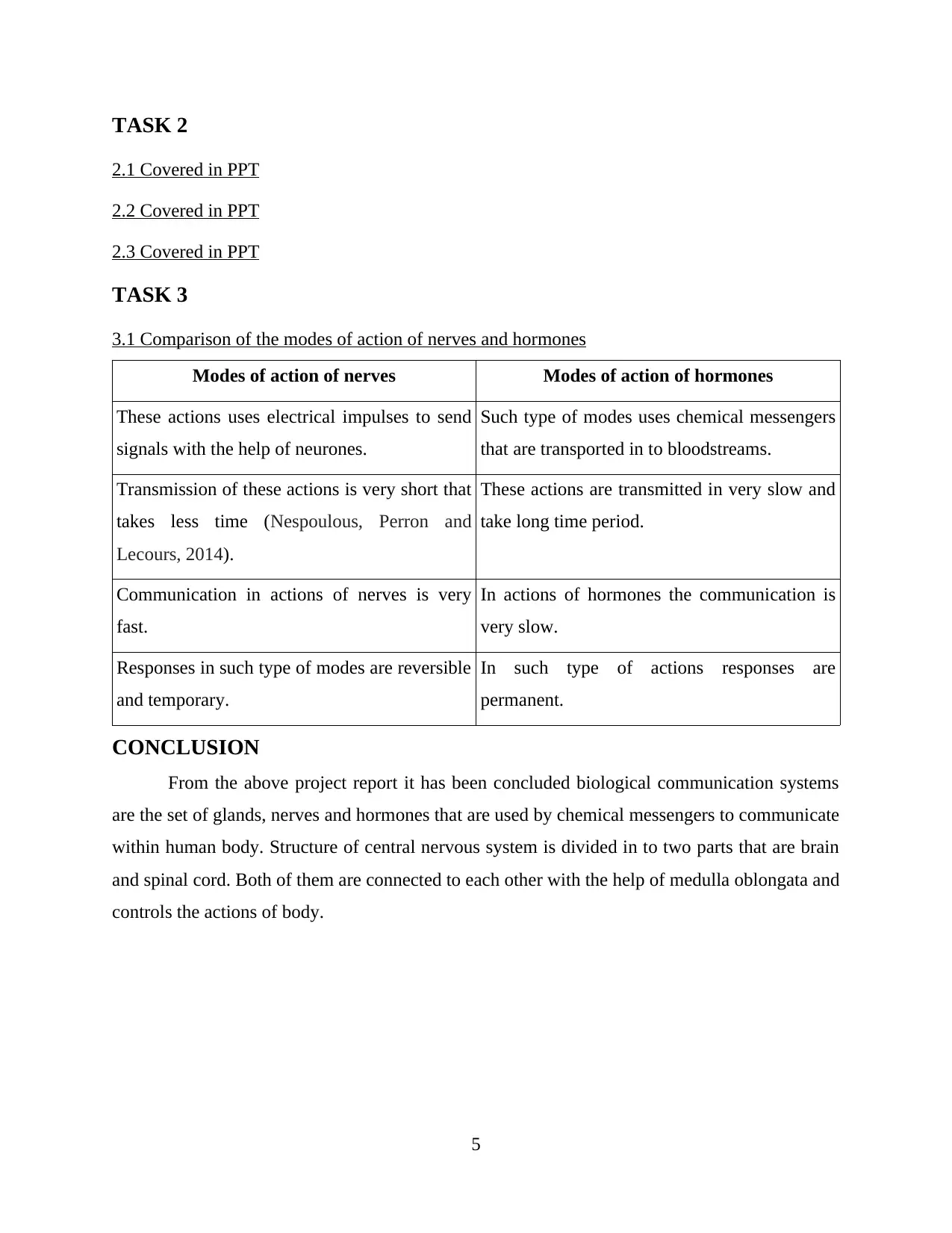
TASK 2
2.1 Covered in PPT
2.2 Covered in PPT
2.3 Covered in PPT
TASK 3
3.1 Comparison of the modes of action of nerves and hormones
Modes of action of nerves Modes of action of hormones
These actions uses electrical impulses to send
signals with the help of neurones.
Such type of modes uses chemical messengers
that are transported in to bloodstreams.
Transmission of these actions is very short that
takes less time (Nespoulous, Perron and
Lecours, 2014).
These actions are transmitted in very slow and
take long time period.
Communication in actions of nerves is very
fast.
In actions of hormones the communication is
very slow.
Responses in such type of modes are reversible
and temporary.
In such type of actions responses are
permanent.
CONCLUSION
From the above project report it has been concluded biological communication systems
are the set of glands, nerves and hormones that are used by chemical messengers to communicate
within human body. Structure of central nervous system is divided in to two parts that are brain
and spinal cord. Both of them are connected to each other with the help of medulla oblongata and
controls the actions of body.
5
2.1 Covered in PPT
2.2 Covered in PPT
2.3 Covered in PPT
TASK 3
3.1 Comparison of the modes of action of nerves and hormones
Modes of action of nerves Modes of action of hormones
These actions uses electrical impulses to send
signals with the help of neurones.
Such type of modes uses chemical messengers
that are transported in to bloodstreams.
Transmission of these actions is very short that
takes less time (Nespoulous, Perron and
Lecours, 2014).
These actions are transmitted in very slow and
take long time period.
Communication in actions of nerves is very
fast.
In actions of hormones the communication is
very slow.
Responses in such type of modes are reversible
and temporary.
In such type of actions responses are
permanent.
CONCLUSION
From the above project report it has been concluded biological communication systems
are the set of glands, nerves and hormones that are used by chemical messengers to communicate
within human body. Structure of central nervous system is divided in to two parts that are brain
and spinal cord. Both of them are connected to each other with the help of medulla oblongata and
controls the actions of body.
5
Paraphrase This Document
Need a fresh take? Get an instant paraphrase of this document with our AI Paraphraser
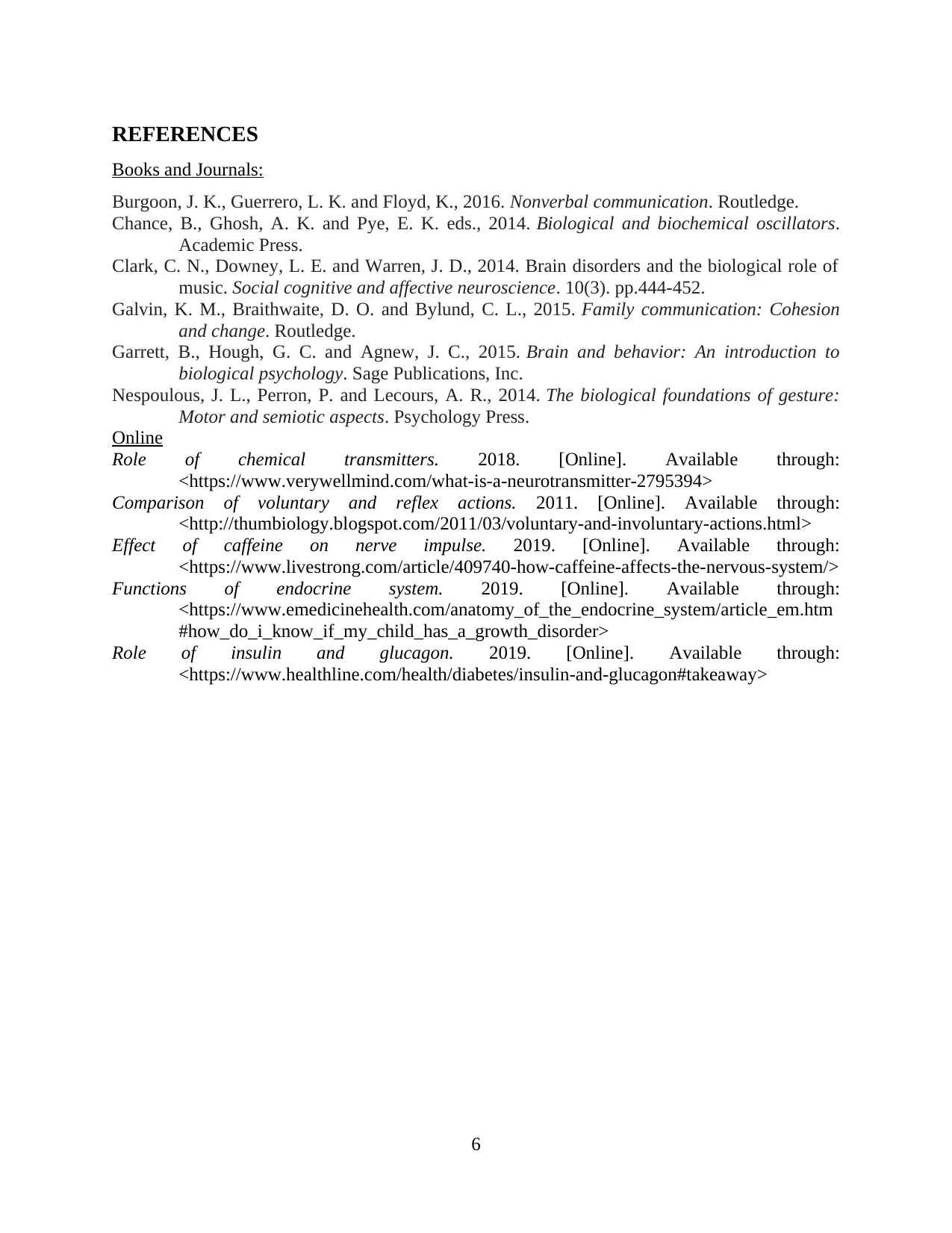
REFERENCES
Books and Journals:
Burgoon, J. K., Guerrero, L. K. and Floyd, K., 2016. Nonverbal communication. Routledge.
Chance, B., Ghosh, A. K. and Pye, E. K. eds., 2014. Biological and biochemical oscillators.
Academic Press.
Clark, C. N., Downey, L. E. and Warren, J. D., 2014. Brain disorders and the biological role of
music. Social cognitive and affective neuroscience. 10(3). pp.444-452.
Galvin, K. M., Braithwaite, D. O. and Bylund, C. L., 2015. Family communication: Cohesion
and change. Routledge.
Garrett, B., Hough, G. C. and Agnew, J. C., 2015. Brain and behavior: An introduction to
biological psychology. Sage Publications, Inc.
Nespoulous, J. L., Perron, P. and Lecours, A. R., 2014. The biological foundations of gesture:
Motor and semiotic aspects. Psychology Press.
Online
Role of chemical transmitters. 2018. [Online]. Available through:
<https://www.verywellmind.com/what-is-a-neurotransmitter-2795394>
Comparison of voluntary and reflex actions. 2011. [Online]. Available through:
<http://thumbiology.blogspot.com/2011/03/voluntary-and-involuntary-actions.html>
Effect of caffeine on nerve impulse. 2019. [Online]. Available through:
<https://www.livestrong.com/article/409740-how-caffeine-affects-the-nervous-system/>
Functions of endocrine system. 2019. [Online]. Available through:
<https://www.emedicinehealth.com/anatomy_of_the_endocrine_system/article_em.htm
#how_do_i_know_if_my_child_has_a_growth_disorder>
Role of insulin and glucagon. 2019. [Online]. Available through:
<https://www.healthline.com/health/diabetes/insulin-and-glucagon#takeaway>
6
Books and Journals:
Burgoon, J. K., Guerrero, L. K. and Floyd, K., 2016. Nonverbal communication. Routledge.
Chance, B., Ghosh, A. K. and Pye, E. K. eds., 2014. Biological and biochemical oscillators.
Academic Press.
Clark, C. N., Downey, L. E. and Warren, J. D., 2014. Brain disorders and the biological role of
music. Social cognitive and affective neuroscience. 10(3). pp.444-452.
Galvin, K. M., Braithwaite, D. O. and Bylund, C. L., 2015. Family communication: Cohesion
and change. Routledge.
Garrett, B., Hough, G. C. and Agnew, J. C., 2015. Brain and behavior: An introduction to
biological psychology. Sage Publications, Inc.
Nespoulous, J. L., Perron, P. and Lecours, A. R., 2014. The biological foundations of gesture:
Motor and semiotic aspects. Psychology Press.
Online
Role of chemical transmitters. 2018. [Online]. Available through:
<https://www.verywellmind.com/what-is-a-neurotransmitter-2795394>
Comparison of voluntary and reflex actions. 2011. [Online]. Available through:
<http://thumbiology.blogspot.com/2011/03/voluntary-and-involuntary-actions.html>
Effect of caffeine on nerve impulse. 2019. [Online]. Available through:
<https://www.livestrong.com/article/409740-how-caffeine-affects-the-nervous-system/>
Functions of endocrine system. 2019. [Online]. Available through:
<https://www.emedicinehealth.com/anatomy_of_the_endocrine_system/article_em.htm
#how_do_i_know_if_my_child_has_a_growth_disorder>
Role of insulin and glucagon. 2019. [Online]. Available through:
<https://www.healthline.com/health/diabetes/insulin-and-glucagon#takeaway>
6
1 out of 8
Related Documents
Your All-in-One AI-Powered Toolkit for Academic Success.
+13062052269
info@desklib.com
Available 24*7 on WhatsApp / Email
![[object Object]](/_next/static/media/star-bottom.7253800d.svg)
Unlock your academic potential
© 2024 | Zucol Services PVT LTD | All rights reserved.





